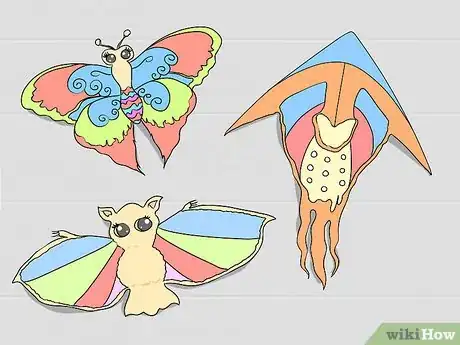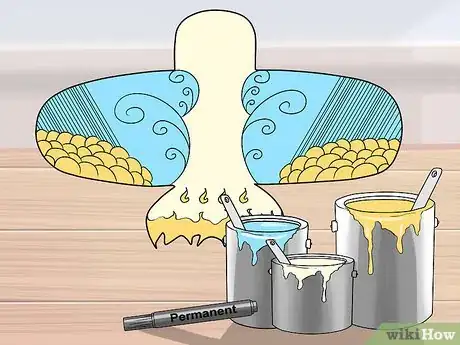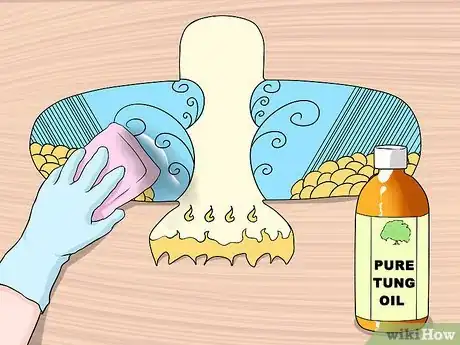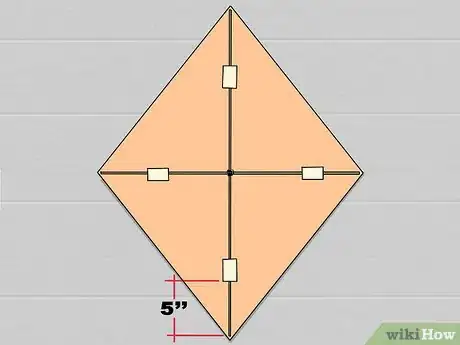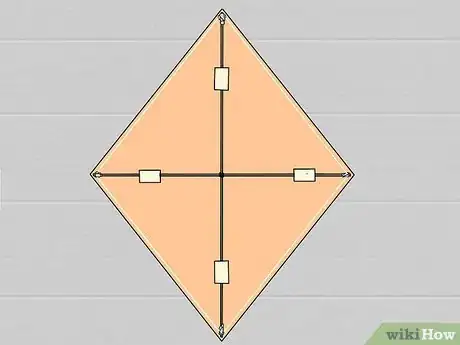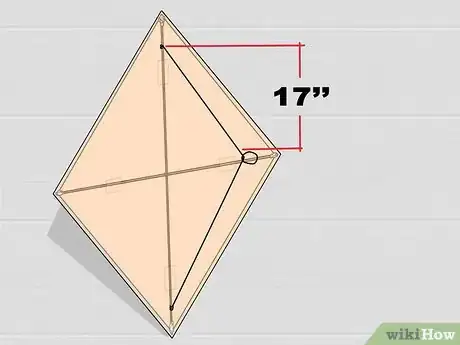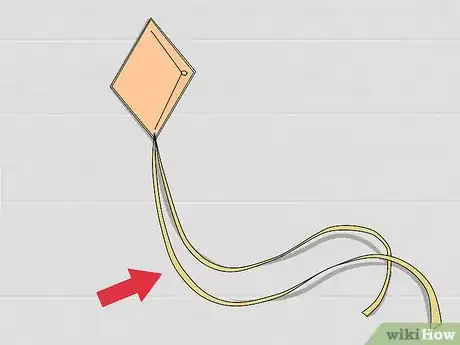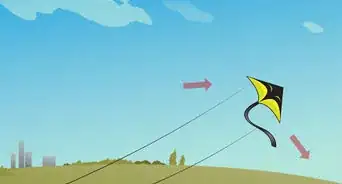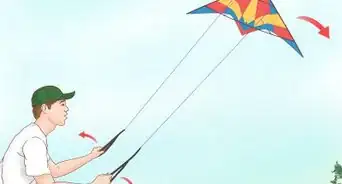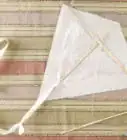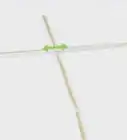This article was co-authored by wikiHow Staff. Our trained team of editors and researchers validate articles for accuracy and comprehensiveness. wikiHow's Content Management Team carefully monitors the work from our editorial staff to ensure that each article is backed by trusted research and meets our high quality standards.
This article has been viewed 160,550 times.
Learn more...
Chinese kite making is considered an art form in China, and in some Chinese families, kite-making techniques and patterns have been passed down for generations.[1] Chinese kite making involves using bamboo and paper to make kites that can range from the size of a postcard to several feet high.
Steps
Gathering the Supplies
-
1Look for high quality bamboo. Unlike other kites, Chinese kites are traditionally made from strips of bamboo. You can find bamboo at specialty art supply shops and online. The bamboo is then cut into thin strips with a knife and used as the frame for the kite.[2]
- If you cannot find bamboo, you can use thin wooden dowels from your local art supply store. However, the traditional Chinese way of making kites uses bamboo.
-
2Select thin silk or thin, long fiber paper. Chinese kites are usually fashioned from thin silk or thin, long fiber paper. You can find thin silk at your local fabric store and look for thin, long fiber paper at your local craft store. Long fiber paper contains long, natural fibers, such as hemp, and is known for being strong and light.[3] Kites made with thin silk are considered more high quality than kites made with paper.[4]
- Some kite makers use newspaper or construction paper for their kites. The traditional Chinese kite is usually made of thin silk or high quality paper, but you can use newspaper if you do not have access to silk or specialty paper.
Advertisement -
3Gather the other supplies for the kite. To round out your supplies list for the kite, you should ensure you have:
- 8.5 x 11" (21 x 29.7 cm) plain paper
- Masking tape and/or glue
- Scissors
- Twine
- Spool of thread and a needle
- Measuring tape
- A crepe streamer
- Paint and/or markers to decorate the kite
Designing and Decorating the Kite
-
1Choose the design for the kite. Chinese kite designs vary from simple fighting kites that are small and quick to the more complex dragon, goldfish, and swallow-shaped kites. You may want to choose a simpler design for your first Chinese kite and then progress to more difficult designs as you become more proficient at shaping.[5]
- Consider a design in the shape of an animal, like a bird, a butterfly, or a dragonfly. Chinese kites usually use an animal design or representations of animals. No matter what animal you choose, you should go for a shape that is symmetrical, with equal material on either side of the kite.
- Another option is to choose a diamond or circle as the shape for your kite. You could then decorate the diamond or circle with animal images.
-
2Make the body of the kite. Once you have selected a kite design, you should make the body of the kite. The kite can be made out of a sheet of thin, long fiber paper or newspaper.
- To make the kite, draw or trace an image of the animal you are going to use for the kite. For example, if you are using a butterfly shape, you could trace one butterfly wing on one side of the piece of paper. You could then fold the piece of paper in half and cut out the wings. This will ensure you have a symmetrical kite, with two equal halves. The same process can be applied for a diamond or circle shape as well.
-
3Cover the kite with a piece of paper. Once you have completed the kite body, you should cover it with another piece of paper, newspaper, or thin silk so it is durable and strong. If you are using thin silk, you should work carefully and slowly as you do not want to tear the silk.
- Place the kite along the fold of the newspaper or the middle of the piece of paper. Trace the kite on the paper and cut it out. Then, attach the cover to the kite with tape, taping along the sides of the kite.
-
4Decorate the kite. It is easier to decorate the kite when it is flat and does not yet have a frame. Get creative and use paints, markers, or colored pencils to draw designs on the kite. If you are using an animal shape, like a butterfly or a bird, draw in details found in nature, such as butterfly wing designs or bird feathers. Use bright, vibrant colors so the kite looks pretty when it is flying in the wind.[6]
- If you are using a diamond or circle shape for the kite body, you can still draw representations of animals on the kite. Cut out images of your favorite animal and paste them on the kite or draw images that are colorful and interesting on the kite.
-
5Put tung oil on the kite. According to Chinese tradition, the kite body is usually treated with tung oil or Chinawood oil, which is made from the Euphorbiaceae tree, found throughout central Asia. This will allow the paper to remain stiff but lightweight. If you do not have access to tung oil, you can skip this step.[7]
Framing the Kite and Adding the String
-
1Frame the kite with the bamboo or the wooden dowels. Make a frame with bamboo or wooden dowels to ensure the kite stays airborne once it is in the sky. You will need to cut the bamboo or the dowels so they fit the shape of the kite.
- Cut the bamboo or the dowel so they are long enough to cross over the center of the kite. One piece will go lengthwise and one piece will go width wise, forming a “T” shape on the kite. If you are using wooden dowels, you should wrap the end of the dowels in masking tape so they do not pierce through the paper and damage your kite.
- Lay the dowels or the bamboo so they form a “T” shape. Use twine to secure the two pieces together in the middle of the kite. You can also use glue or masking tape to secure the pieces extra well as you do not want the middle of the dowels to come off the kite.
- Secure the bamboo or the dowels to the kite. Use masking tape to secure the bamboo to the kite. Place the tape five inches (12.7 cm) below the edge of the kite on each dowel or piece of bamboo.
-
2Use twine to finish the frame. Wrap the twine around the tip of one dowel and then run it around the ends of the other dowel so the twine outlines the shape of the kite. Keep the twine taut as you wrap it around the dowels.
- Twist the twine around one end of the dowel and knot it around the end of the towel. Then, secure the twine with a piece of tape. Wrap the tape so it is folded securely over the twine.
- Finish the frame by folding the edge of the paper over the framing twine. Then, unfold it and spread glue over the edges of the dowels. Press the edges over the string and let them air dry. This will ensure the twine frame stays attached to the kite body.
-
3Attach the bridle string. The bridle string is the string that you will use to help fly the kite. Usually it is about three times as long as your kite. The bridle string attaches to the kite at both ends of the frame and then the kite line attaches to the bridle. You can use measuring tape to measure the bridle string so it is at least three times as long as your kite.
- Cut the string once you have measured it and tie one end of the string to the dowel located at the bottom of the kite. Once the string is knotted to the dowel, you can thread it through the paper on the decorated side. This will ensure the decorated image is showing when you fly the kite.
- Thread the other end of the string through the paper at the top of the kite. Knot it to the top of the dowel. The bridle string should now be hanging from the front or decorated side of the kite.
- Place your finger 17” (43.1 cm) down the length of the string from the top of the kite. This is the tow point or the point where the kite reel will be attached to the string. Make a loop in the string at the 17” point.
-
4Make the kite reel. The kite reel is how you will reel out enough string to help the kite fly. You can use a spool of thread or twine as the kite reel for an easy, quick reel. Other options include using a piece of wood or a piece of heavy cardboard.
- Attach the kite reel to the bridle string by tying the kite reel string to the bridle string. Tie the kite reel string just under the 17” (43.1 cm) knot on the bridle string. Then, slide a wooden dowel through the spool of thread and secure it with tape. This will allow the kite reel to release thread easily when the kite is in the air.
-
5Put the tail on the kite. Finish the kite by adding a tail. The tail can be made of a paper streamer and should be at least one and a half times the length of the spine of the kite. Usually a tail that is longer will ensure the kite flies straight. The tail also provides drag for the kite so it can fly at a higher distance and in a straight line.[8]
- You can make a tail that is one long string or several strings tied together. Attach the tail to the bottom end of the kite with tape, making sure it is centered on the kite.
-
6Fly the kite in an open outdoor area. Kites fly best outside in an open area like a field. Choose a day with winds that are not too light or too strong, usually between 5 to 25 mph (8 to 40 km/h).
- Never fly the kite near power lines or other tall obstructions as it can get tangled and become damaged.
Community Q&A
-
QuestionDid the Chinese make kites in the shape of butterflies?
 Community AnswerSometimes their kites were in the shape of butterflies, but sometimes they were not.
Community AnswerSometimes their kites were in the shape of butterflies, but sometimes they were not. -
QuestionWhat do traditional Chinese kites look like? I can't find much about what they looked like.
 Community AnswerTry doing a google search for "traditional Chinese kites" and they click on the link for images at the top.
Community AnswerTry doing a google search for "traditional Chinese kites" and they click on the link for images at the top.
Things You'll Need
- Bamboo or wooden dowels
- Thin, long fibered paper or thin silk
- 8.5 x 11"(21 x 29.7 cm) plain paper or newspaper
- Masking tape and/or glue
- Scissors
- Twine
- Spool of thread and a needle
- Measuring tape
- A crepe streamer
- Paint and/or markers to decorate the kite
References
- ↑ http://www.chinahighlights.com/travelguide/culture/kites.htm
- ↑ https://www.travelchinaguide.com/intro/arts/kites.htm
- ↑ http://www.glatfelter.com/products/technical_specialties/long_fiber_papers.aspx
- ↑ https://www.travelchinaguide.com/intro/arts/kites.htm
- ↑ http://www.chinahighlights.com/travelguide/culture/kites.htm
- ↑ http://www.chinahighlights.com/travelguide/culture/kites.htm
- ↑ http://www.chinahighlights.com/travelguide/culture/kites.htm
- ↑ http://www.scientificamerican.com/article/bring-science-home-kite-tails/
About This Article
If you want to make a Chinese kite, cut out the shape of your kite from two layers of thin fiber paper or newspaper and decorate your kite with paint, markers, or colored pencils. Make a frame by attaching 2 bamboo or wooden dowels with twine in a T-shape. Attach the frame to the kite with tape, then tie twine to the tip of each dowel so it outlines the shape of the kite. Make a bridle string that’s 3 times the length of your kite and attach it to both ends of the frame. Tie your kite reel to the bridle string and attach the tail, then take your kite for its first flight! For tips on making your kite look like an animal, read on!



